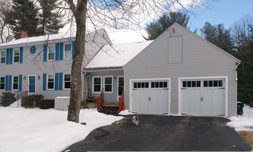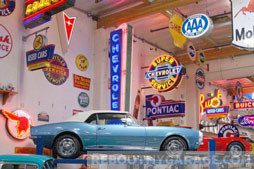Turn Your Garage From a Dark Cave to a Bright Workshop
Deciding on the right color and quality of your garage lights is just the beginning. The real question is how many lamps you actually need to properly illuminate your space. It’s the secret to turning a dim, underused garage into a bright, functional workshop.
You don’t need to be an electrical engineer to figure it out. With a few simple measurements and our easy-to-use calculator, you’ll have a precise number in seconds. This clarity will give you the confidence to click the “buy” button and finally get the lighting your garage deserves.
Knowing the right quantity of lights is crucial for creating an evenly lit, safe, and productive environment. Too few lights, and you’ll be working in your own shadow. Too many, and you’re just wasting energy and money.
If you’re starting from scratch and need help choosing the best type of light, our guide can help. Explore our top recommendations before you calculate your needs. Find the perfect lights for your project right here: The Best Garage Lights.
How Many Garage Lamps? Use This Calculator

Getting the perfect lighting layout starts with a single number: the total quantity of lamps. The calculator below is designed to give you that exact answer. It removes the guesswork and provides a clear, actionable result based on your garage’s unique details.
The calculation is based on industry standards for workspace and general-purpose lighting. It takes your garage size, your intended use, and the specific lights you’ve chosen into account. This data-driven approach ensures you get it right the first time.
Simply enter the width and depth of your garage, choose your desired brightness, and input the “lumens” rating from the lamps you plan to buy. The tool will do the rest, telling you exactly how many units to purchase to properly light your garage.
Once you have your number, you’re ready to move forward. This simple step makes your garage safer, more efficient, and far more enjoyable to work in. Let’s get started.
Step 1: Measure Your Garage’s Dimensions

The foundation of any good lighting plan is accurate measurement. Start by inputting the width and depth of your garage in feet. This simple data point is the most critical factor in determining your overall lighting needs.
If you can’t measure your space right away, you can use common dimensions as a starting point. A typical one-car garage is often around 12 feet wide by 22 feet deep. A standard two-car garage is usually closer to 20 feet by 20 feet.
Using these estimates will give you a good approximation to begin your research. However, for the most accurate results, we always recommend measuring your specific space. Every foot counts when it comes to creating a perfectly balanced lighting environment.
Grab a tape measure and get a precise reading. These two numbers—width and depth—are the first step toward calculating your ideal lighting setup.
Step 2: Choose Your Desired Brightness

Next, you need to decide how bright you want your garage to be. This is measured in a unit called lumens per square foot, also known as foot-candles. The right level depends entirely on how you use your garage.
For general purposes like parking your car and basic storage, a goal of 50 lumens per square foot is an excellent target. This provides crisp, clear visibility that far exceeds the standard single-bulb setup.
However, if your garage doubles as a workshop, you’ll want a much brighter space. For detailed tasks like car maintenance, woodworking, or crafting, aim for a higher intensity of 70 to 100 lumens per square foot. This level of brightness reduces eye strain and helps you see every detail with perfect clarity.
Choosing the right brightness level is about matching the light to your lifestyle. Be honest about your activities to create a space that truly works for you. For a deeper dive into lighting goals, explore our complete garage lighting guide.
Step 3: Find the Lumens Per Lamp

The final piece of the puzzle is the specific light output of the lamps you intend to buy. Check the product’s packaging or online description for its “lumens” rating. This number indicates the total amount of visible light the lamp emits.
Enter this value into the calculator for a precise recommendation. Different lights have vastly different lumen outputs, so using the correct number is essential for an accurate calculation. Don’t confuse lumens with watts, which measure energy consumption, not brightness.
If you haven’t selected a specific light fixture yet, don’t worry. You can use 4,200 lumens as a fantastic starting point for your calculation. This is a common output for many powerful and efficient LED garage lights on the market today.
Using a placeholder value allows you to understand the approximate number of fixtures you’ll need. You can then adjust your shopping list based on the actual lumen rating of the lights you decide to purchase.
What Is Color Temperature and Why Does It Matter?

While you’re checking the lumen rating, take a moment to look for another important value: “Color Temperature.” This is measured in Kelvin (K) and determines whether the light appears warm (yellowish) or cool (bluish-white). It dramatically affects the look and feel of your garage.
For a garage environment, especially one used as a workspace, you should avoid warm, cozy lighting. Instead, opt for a color temperature that mimics natural daylight. This creates a clean, clear atmosphere that is ideal for tasks requiring focus and accuracy.
We recommend choosing a lamp with a rating between 4,000K and 5,000K. This range produces a neutral to cool white light that renders colors accurately and enhances visibility. It’s the standard for professional workshops and showrooms for a reason.
Getting the color temperature right is just as important as getting the brightness right. This simple choice will make your garage feel less like a basement and more like a high-end, productive space.
Why a Single Bulb Setup Fails Every Time

For decades, the standard for garage lighting was a single, bare incandescent bulb hanging from the ceiling. This approach is fundamentally flawed. It creates a space with harsh shadows, poor visibility, and a dreary, uninviting atmosphere.
Working on a car, finding a tool, or even just navigating the space becomes a challenge. A single point of light cannot possibly illuminate the corners, undercarriages, or workbenches effectively. It’s a recipe for frustration, lost items, and even potential safety hazards.
Modern lighting solutions are designed to overcome these challenges. By using multiple, strategically placed lamps, you create overlapping fields of light. This method eliminates shadows and provides consistent, even illumination across the entire garage.
Upgrading your lighting is one of the most impactful changes you can make. It moves your garage from a forgotten storage space into a fully functional and valuable extension of your home.
How Better Lighting Improves Your DIY Projects

Proper lighting is not just a luxury; it’s a tool that directly impacts the quality of your work. Whether you’re a classic car enthusiast, a weekend woodworker, or a dedicated DIYer, good light is non-negotiable. It allows you to work with precision and confidence.
Imagine trying to spot a small oil leak under a poorly lit engine bay or matching a paint color in a dim, yellow light. The right lighting eliminates these struggles. A bright, daylight-balanced environment helps you see true colors, spot imperfections, and read small measurements with ease.
This improved visibility leads to fewer mistakes and better results. It also significantly enhances safety. You are far less likely to trip over a cord or mishandle a tool when your entire workspace is clearly illuminated.
Upgrading your garage lighting helps you get the most out of your hobbies and projects. It helps you do your best work and makes time in the garage more enjoyable and productive.
Where Should You Place Your New Garage Lights?

Knowing how many lamps to buy is the first step, but where you put them is just as important. The goal of your layout should be to create a seamless blanket of light. This requires thinking about more than just a simple grid on the ceiling.
Start with general overhead lighting, spaced evenly to cover the main floor area. This will handle the bulk of the illumination for parking and moving around the space. The calculator gives you the number of lights you need for this primary coverage.
Next, consider adding dedicated task lighting. If you have a workbench, install a light directly above it to eliminate shadows cast by your own body. If you work on cars, consider adding lights along the side walls to illuminate the vehicle’s profile.
Strategic placement turns a bright room into a functional workspace. By layering your lighting, you ensure that every corner, surface, and angle is perfectly lit for whatever project you’re tackling.
The Modern Choice: LED Over Fluorescent

When it comes to technology, the choice is clear: LED lighting is the superior option for any modern garage. While fluorescent tubes were once the standard upgrade, they have been surpassed by LEDs in almost every way. The benefits of making the switch are undeniable.
LED lights are significantly more energy-efficient, using up to 75% less energy than their fluorescent counterparts. This translates directly to lower electricity bills over the long run. They also have an incredibly long lifespan, with many fixtures rated for 50,000 hours or more.
Unlike fluorescents, LEDs provide instant-on, full-level brightness, even in cold temperatures. There’s no buzzing, no flickering, and no waiting for your lights to “warm up.” They are also more durable, as they don’t contain fragile glass tubes or hazardous materials like mercury.
Choosing LED is a smart, forward-thinking decision. It provides better performance, lower running costs, and greater reliability, making it the definitive choice for your garage upgrade.
How to Use Your Calculator Results

The calculator has given you a number—now what? This figure represents the ideal number of lamps needed to achieve your desired brightness level for general illumination. Think of it as your base layer of light.
If the calculator gives you a fractional number, like 5.7, it’s almost always best to round up to the next whole number. In this case, you would purchase 6 lamps. It’s better to be slightly brighter than to fall short of your lighting goal.
Use this number to plan the layout on your ceiling. For example, if you need 6 lamps for a two-car garage, you could arrange them in two rows of three, ensuring even coverage over each bay. Sketching out a simple diagram can be incredibly helpful.
Remember, this calculation is for your primary overhead lighting. You can always supplement this with additional task lighting over specific work areas. Your result from the calculator is the strong foundation on which your entire lighting system is built.
Your Final Step: Choose the Perfect Lights

You are now equipped with the knowledge to create a truly outstanding garage lighting system. You know how to measure your space, define your brightness goals, and calculate the exact number of lamps you need. The guesswork has been completely eliminated.
With your ideal number of lamps in hand, you can shop with total confidence. You’re no longer just buying a product; you’re executing a well-thought-out plan. This is the difference between a simple purchase and a genuine upgrade to your home.
The final step is to select a high-quality, reliable light that will serve you for years to come. The right fixture will bring your entire lighting plan to life, bathing your garage in crisp, clear, and useful light.
Now that you know the quantity, it’s time to focus on quality. We’ve tested and reviewed the best options on the market to make your decision easy. See our top recommendations and find the perfect lights for your newly planned space right here: See The Best Garage Lamps Now.









